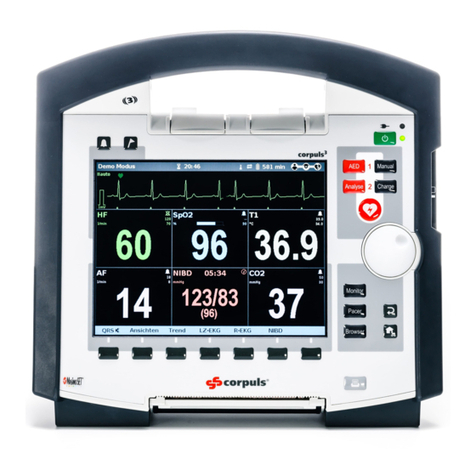
User Manual corpuls3
Contents
ENG - Version 2.1 – P/N 04130.2 vii
4.3 Menu Control................................................................................. 46
4.3.1 Softkey Context Menu.............................................................. 46
4.3.2 Parameter Context Menu and Curve Context Menu ............... 47
4.3.3 Main Menu ............................................................................... 49
4.3.4 Configuration Dialogue ............................................................ 50
4.4 Disconnecting and Connecting Modules ...................................... 51
4.4.1 Disconnecting the Monitoring Unit from the
Defibrillator/Pacer .................................................................... 51
4.4.2 Disconnecting the Patient Box from the Monitoring
Unit........................................................................................... 52
4.4.3 Connecting the Patient Box to the Monitoring Unit.................. 53
4.4.4 Connecting the Monitoring Unit to the
Defibrillator/Pacer .................................................................... 54
4.4.5 Removing the Patient Box from the Compact Device ............. 55
4.5 Accessory Bag.............................................................................. 56
4.5.1 Fitting the Accessory Bag........................................................ 56
4.5.2 Packing the Accessory Bag..................................................... 57
4.6 Inserting the Device into the Brackets.......................................... 60
4.6.1 Defibrillator/Compact Device Bracket...................................... 60
4.6.2 Monitoring Unit Bracket............................................................ 61
4.6.3 Patient Box Charging Bracket.................................................. 62
5Operation – Therapy ........................................................................ 63
5.1 Therapy Electrodes for Defibrillation and Pacing.......................... 63
5.1.1 Types of Therapy Electrodes................................................... 63
5.1.2 Connecting the Electrode Cable.............................................. 65
5.1.3 Removing the Shock Paddles from their Holders and
Re-inserting them..................................................................... 66
5.2 Preparing the Patient for Defibrillation, Cardioversion and
Pacer Therapy............................................................................... 67
5.3 Defibrillation in AED Mode............................................................ 68
5.3.1 Information on the AED Mode ................................................. 68
5.3.2 Defibrillation in AED mode with corPatch Electrodes........... 70
5.3.3 Defibrillation in AED Mode with Shock Paddles ...................... 71
5.4 Manual Defibrillation and Cardioversion....................................... 74
5.4.1 Information on Manual Defibrillation and
Cardioversion........................................................................... 74
5.4.2 Manual Defibrillation with corPatch Electrodes.................... 76
5.4.3 Manual Defibrillation and Cardioversion with Shock
Paddles.................................................................................... 77
5.4.4 Manual Defibrillation and Cardioversion with Shock
Spoons..................................................................................... 79
5.4.5 Manual Defibrillation and Cardioversion of Neonates
and Children............................................................................. 80
5.5 External Pacer............................................................................... 81
5.5.1 Information on the External Pacer........................................... 81
5.5.2 Preparing the pacer function.................................................... 83





























